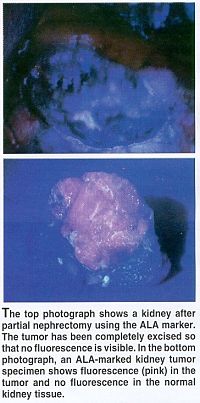Fluorescent Marker Permits Clean Partial Nephrectomy
ATLANTA-A fluorescent marker given 4 hours before surgery lights up renal cell carcinoma cells and eliminates the need for frozen sections to guarantee clean margins during kidney-preserving tumor resection, German researchers reported in a poster presented at the 95th Annual Meeting of the American Urological Association (AUA).
ATLANTAA fluorescent marker given 4 hours before surgery lights up renal cell carcinoma cells and eliminates the need for frozen sections to guarantee clean margins during kidney-preserving tumor resection, German researchers reported in a poster presented at the 95th Annual Meeting of the American Urological Association (AUA).
Gralf Popken, MD, told ONI in an interview that a single oral 20 mg/kg dose of 5-aminolevulinic acid (ALA) produces maximal fluorescence 4 hours after administration and that this is enough to identify the outer margins of renal cell tumors during resection. Dr. Popken is assistant professor of urology, University of Freiburg, Germany.
ALA is converted to protoporphyrin IX (PPIX), which is eliminated from normal cells, Dr. Popken said. In malignant epithelial tumors, such as renal cell carcinoma, glioblastoma, and bladder cancer, this enzymatic process is defective. PPIX accumulates in these cells.
Shining a blue light on these cells makes them fluoresce in the visible red region of the spectrum. This fluorescence distinguishes the tumor from the healthy surrounding tissue, Dr. Popken said.
This process requires a xenon light system and a yellow filter, but Dr. Popken said that existing endoscopic light systems could be adapted easily for this use.
The process was tested first in an animal model in which human renal cell carcinoma was xenotransplanted into nude mice. In this animal model, the ALA marker was easily detectable both within the kidney at operation and in the dissected tumor. Maximum tissue levels of the marker were reached at 1.5 hours after intravenous administration and at 4 hours after oral administration.

The technique was then tested during resection in 35 patients with renal tumors less than 4 cm in diameter. Patients received oral ALA 4 hours before their surgery. A retroperitoneal approach was used, and the tumor was excised under cold ischemia with a safety margin of 0.3 to 0.5 cm (see Figures).
In this pilot study, Dr. Popken said that good fluorescence appeared in all 31 patients with renal cell tumors; there was no fluorescence in the 4 benign tumors.
This was sufficient to identify outer margins of the tumors for kidney-preserving tumor resection, he reported. There were no local recurrences during the follow-up period of 18 months. The investigators also observed no side effects of oral ALA as given in the trial.
Dr. Popken said that the ALA method, if further validated, is expected to enable surgeons to do partial rather than full nephrectomies for more patients who have renal cell carcinoma.
For physicians who see patients with kidney tumors, this will increase the importance of sending these patients for surgery to centers experienced in and potentially able to do partial nephrectomies, he said.
Dr. Popken expects the new procedure to be particularly helpful in the treatment of patients who have recurrent multiple tumors. He told ONI that being able to identify and remove all tumors at the same time in such patients will help surgeons reset the clock more completely and potentially lengthen the interval between recurrences.